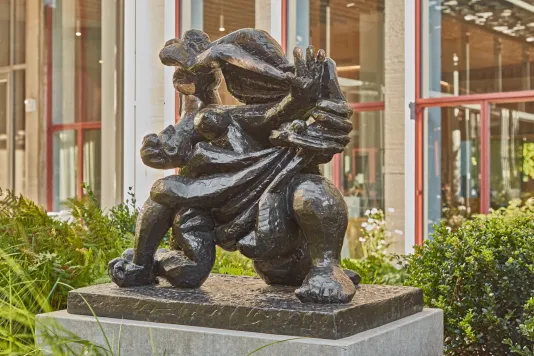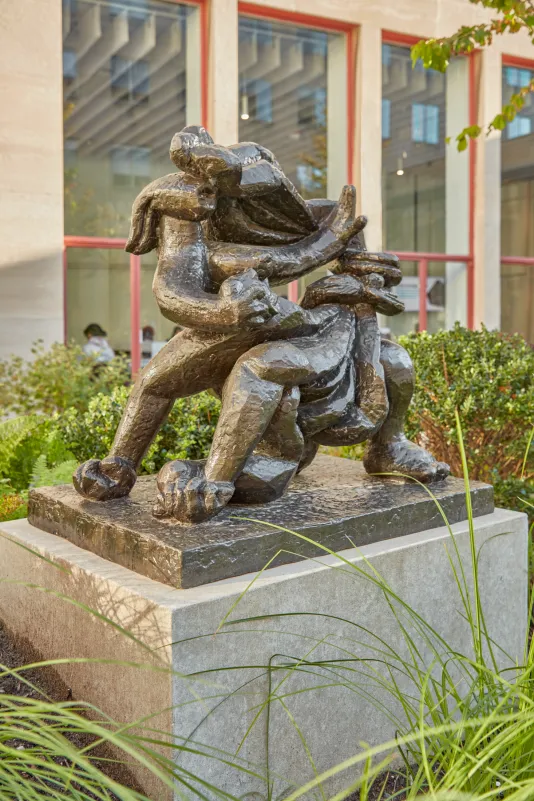Jacques Lipchitz, Hagar in the Desert, 1957. Gift of Yulla Lipchitz in Memory of Dr. Jerome B. Wiesner. Photo: Charles Mayer Photography
Hagar in the Desert, 1957

"3 Piece Flavor" by Lupe Fiasco, GHOTIING MIT: Public Art
Following his escape from occupied France in 1941, Jacques Lipchitz often turned to Jewish ceremonial and historical subjects. In a series of sculptures, he represented the Biblical story of Hagar, Sarah’s handmaiden and the mother of Abraham’s first-born son, Ishmael.
When Sarah was finally able to conceive her own child with Abraham, they consigned Hagar and Ishmael to the desert. During their banishment, Hagar and her child were parched, and Hagar, in her despair, is said to have heard an angel’s voice and, in a vision, been shown the spring that was her salvation. Ishmael, who is regarded as a prophet in Islam, is said to have settled in Mecca, and is believed to be an ancestor to Mohammed.
In this bronze sculpture, Lipchitz has imagined Hagar offering her child comfort in her arms. The enlarged limbs, rhetorical gestures, angular forms, and roughly modeled surfaces of the work convey a sense of struggle, without clearly differentiating mother from child or comfort from crisis. This tale of betrayal, protection, and displacement, important to the origins of Judaism, may have resonated with Lipchitz given the Jewish sculptor’s forced flight from Europe as well as his second marriage in America. The dates of this sculpture series illuminate another dimension: Lipchitz’s first sculpture on this theme was made in 1948, the year of the Arab-Israeli war. In referencing the distanced relation between Isaac and Ishmael, the artist framed the works as a “prayer for brotherhood!”
Jacques Lipchitz (1891–1973) was born in Lithuania as Chaim Jacob Lipchitz. After studying engineering at a secondary school in Vilna, he moved to Paris in 1909, where he attended classes at the city’s prestigious École des Beaux-Arts, Académie Julian, and Académie Colarossi. From the stylized figurative sculpture of his early years in Paris, Lipchitz’s work gradually developed as he absorbed ideas from Cubist painters of his time. By 1915, he had evolved a fully Cubist sculptural idiom. Lipchitz worked in France until the German invasion in 1940, after which he immigrated to New York. From that point on, his sculpture became more narrative and autobiographical, emphasizing biblical or personal themes. Lipchitz exhibited regularly in exhibitions in Paris beginning in 1912 and received the first of numerous solo exhibitions in 1920. His works have been displayed at the Petit Palais, Paris; Portland Museum of Art, Maine; Museum of Modern Art, New York; the 26th Venice Biennale (1952); Corcoran Gallery, Washington, D.C.; San Francisco Museum of Art; Walker Art Center, Minneapolis; Detroit Institute of Arts; the Metropolitan Museum of Art, New York; and numerous other international venues. Lipchitz is especially remembered at MIT for his support of the Institute’s program in the arts. In 1965, students enrolled in Professor Stanford Anderson’s seminar on modern art were invited to tour his studio in New York.
